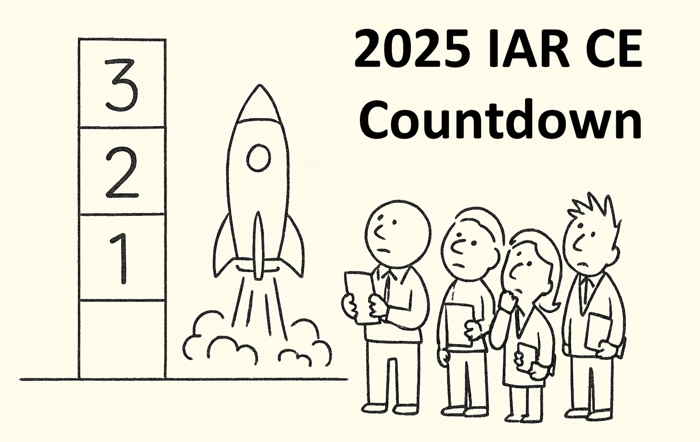Table of Contents
- Why Does Powell Still Insist on 1.8% GDP Growth Cap?
- The President’s Firing of the BLS Chief and Push for Semiannual Corporate Reports
- How BLS Could Be So Wrong on Job Formation Data?
- Can GDP Growth Close The Spending-Revenue Gap
- The Wealth Gap, Political Risk, and Market Stability
- Data Collection Challenges at the Bureau of Labor Statistics
- End Notes On September 2025 IAR CE Economic Update
- FAQs
Fritz Meyer Answers Advisor Questions Live, September 2025
The September 18, 2025 live webinar with economist Fritz Meyer ran long, but most attendees stayed for the lively Q&A session. To keep the on-demand version of the session short, the question-and-answer segment was omitted. This post recaps those exchanges and let's you read and listen exactly what Fritz Meyer said about the economic outlook, key issues shaping Federal Reserve policy, and fiscal trends, market expectations. Financial professionals—Investment Adviser Representatives (IARs), CFPs, CPAs, and CIMAs—will find this an informative complement to their IAR CE Economic Update and IAR CE Investment Outlook learning requirements. As the economy transitions into late-cycle growth and markets adjust to evolving Fed policy, understanding how economic data connects to investment outcomes has never been more critical for fiduciary advisors.
IAR CE Economic Update, September 2025 Bullet Points |
Fed rate cut |
Weak jobs data |
Weakening construction |
Better PMI data |
Jump in August retail sales |
Jump in Q2 household net worth |
Strong +3.3% Atlanta Fed Q3 GDP forecast |
2.6% inflation (PCED); 2.9% (CPI) |
2026 earnings estimates trending higher |
Record high stock prices |
High P/E ratio |
Why Does Powell Still Insist on 1.8% GDP Growth Cap?
Fritz Meyer questioned Federal Reserve Chairman Jerome Powell’s continued insistence that U.S. GDP cannot sustainably grow faster than 1.8% annually over the long run. Meyer argued that this view is too conservative, noting that even the Congressional Budget Office projects 2% long-term growth and that his own outlook is closer to 2.3%. He pointed to productivity improvements and innovation as persistent tailwinds supporting higher potential growth, despite demographic headwinds and slowing labor force expansion. Meyer reminded attendees that long-term growth is determined by two forces: labor force growth and productivity. While the U.S. labor pool is expanding slowly, technological advancements—from AI integration to automation—could boost output per worker and sustain above-trend growth. For advisors seeking an IAR CE Economic Update grounded in data, this underscores why productivity metrics deserve as much attention as inflation or employment data when assessing long-term investment outlooks.
The President’s Firing of the BLS Chief and Push for Semiannual Corporate Reports
One attendee asked about the political implications of the president’s decision to remove the Bureau of Labor Statistics (BLS) chief and propose reducing corporate reporting frequency from quarterly to semiannual. Meyer did not comment on the politics directly but emphasized that consistent, reliable data are critical to policymaking. He noted that less frequent corporate reporting could reduce transparency for investors and analysts, potentially leading to greater market volatility and less confidence in financial data. Quarterly data help economists identify inflection points—such as shifts in earnings trends or productivity—and semiannual reporting might obscure early warning signals. For professionals pursuing IAR CE Economic Updatre credits, Meyer’s comments were a reminder that timely data flow is essential to effective economic interpretation and sound portfolio management.
How BLS Could Be So Wrong on Job Formation Data?
The conversation turned to the large downward revision to payroll employment growth. Meyer acknowledged that the revision was significant and troubling but noted that data collection challenges have grown in recent years. Many businesses no longer respond to phone surveys or provide timely employment information, which undermines the accuracy of preliminary estimates. Meyer observed that Federal Reserve officials have said the data remain good enough for policy decisions, though the accuracy gap is a concern for economists and market analysts. Andrew Gluck, founder of Advisors4Advisors, added that his own analysis of ten years of BLS revisions showed a surprising result: the last five years actually had smaller average revisions than the five years prior. That means the recent revision was likely a statistical outlier rather than evidence of deteriorating data quality. Gluck’s conclusion, based on data summarized in his earlier blog post, is that the BLS remains a generally reliable source, despite occasional headline-grabbing misses.
Can GDP Growth Close The Spending-Revenue Gap
A question about the level of GDP growth required to close the long-term gap between government spending and tax revenue highlighted one of the most persistent fiscal challenges facing the United States. Meyer explained that achieving balance through growth alone would require an unsustainably high rate—well above 3%—given the current trajectory of entitlement spending and interest costs. He stressed that fiscal discipline, along with productivity-driven growth, would be necessary to narrow the gap without sparking inflation or destabilizing the bond market. For advisors focused on IAR CE Economic Update content, Meyer’s view reinforces the need to monitor both fiscal and monetary trends when assessing long-term investment risk and the sustainability of Treasury yields.
The Wealth Gap, Political Risk, and Market Stability
The September 2025 IAR CE Economic Update indicated some growing concerns about income inequality and its impact on political stability and economic confidence. Meyer acknowledged that the widening wealth gap contributes to political dysfunction and policy uncertainty, both of which can weigh on business confidence and long-term investment. However, he cautioned against overstating the risk of systemic collapse, arguing that the U.S. economy remains resilient thanks to strong institutions, innovation, and the rule of law. He added that while inequality can slow consumption growth, it also drives capital formation—wealthier households tend to save and invest more, indirectly supporting financial markets. Still, the political implications cannot be ignored. Policy gridlock, populist pressures, and fiscal uncertainty could all lead to market volatility, a key consideration for advisors interpreting economic signals for clients.
Data Collection Challenges at the Bureau of Labor Statistics
Meyer elaborated on the BLS’s data collection issues, explaining that technological and cultural changes have made traditional survey methods less effective. Decades ago, BLS staff could call businesses directly to verify employment figures. Today, many companies operate remotely, automate HR systems, or use contractors, complicating the process. Meyer admitted there is no easy solution but stressed the need for modernized data collection and integration of digital reporting systems to maintain the accuracy of critical labor market indicators. For financial professionals, this conversation served as a reminder that even official data carry uncertainty, and interpreting revisions is a vital skill in forming an accurate IAR CE Investment Outlook.
End Notes On September 2025 IAR CE Economic Update
In closing, Meyer reiterated that despite short-term uncertainties, the long-term fundamentals of the U.S. economy remain sound. He maintained his view that productivity gains, innovation, and the continued adaptation of businesses to technology will sustain growth above the Fed’s 1.8% projection. Andrew Gluck added that historical data on job revisions show the recent downward correction may have been overstated. In his analysis using ChatGPT, Gluck found that over the past decade, job revision magnitudes have actually declined, suggesting this year’s sharp adjustment was an anomaly rather than a trend. Together, Meyer and Gluck’s perspectives underscore the value of interpreting data within context rather than reacting to headlines. For advisors pursuing continuing education, these exchanges encapsulate the purpose of IAR CE Economic Update sessions—connecting rigorous economic data analysis with practical investment implications. In an era of shifting inflation expectations and evolving fiscal dynamics, staying informed through evidence-based commentary like Meyer’s helps advisors maintain perspective and client confidence.
To earn IAR CE credit and stay current on the economy, join future Advisors4Advisors Economic Update sessions with Fritz Meyer.
FAQs
What is an IAR CE Economic Update?
An IAR CE Economic Update is a continuing education session designed for Investment Adviser Representatives. It provides timely insights on economic growth, fiscal policy, inflation, and investment trends. The course helps advisors meet annual CE requirements while staying informed on key macroeconomic developments affecting client portfolios.
Why is the September 2025 IAR CE Economic Update important?
The September 2025 IAR CE Economic Update with Fritz Meyer analyzed why the Federal Reserve expects long-term GDP growth of just 1.8%, the impact of government fiscal policy, and recent revisions in labor market data. Advisors gained context for interpreting market volatility and understanding how economic fundamentals influence investment decisions.
Who should attend an IAR CE Economic Update session?
IAR CE Economic Updates are ideal for Investment Adviser Representatives (IARs), CFPs, CPAs, CIMAs, and CFAs who want objective, data-driven insight into the economy and markets. These sessions help fiduciary professionals connect macroeconomic trends to real-world client guidance and compliance needs.
What topics does an IAR CE Economic Update typically cover?
Each IAR CE Economic Update includes analysis of Federal Reserve policy, GDP trends, inflation data, interest rates, and investor sentiment. Topics also include fiscal sustainability, political risk, and productivity—core elements that shape long-term investment strategy.
How does the IAR CE Economic Update benefit advisors and clients?
By combining continuing education with actionable insights, an IAR CE Economic Update helps advisors interpret complex data, anticipate policy changes, and guide clients with confidence. Understanding productivity, inflation, and fiscal trends strengthens both portfolio management and fiduciary credibility.
Where can I earn CE credit through IAR CE Economic Update sessions?
You can earn your IAR CE credit by attending upcoming Advisors4Advisors Economic Update sessions with economist Fritz Meyer. These are approved CE programs for IARs, CFPs, CPAs, and CIMAs. Visit Advisors4Advisors.com/bundles/a4a to register.
Why is economic literacy essential for IARs?
Advisors who understand economic trends can better anticipate market risks and client concerns. The IAR CE Economic Update enhances literacy in key indicators—GDP, employment, inflation, and fiscal policy—allowing IARs to build trust and demonstrate value in every client conversation.




